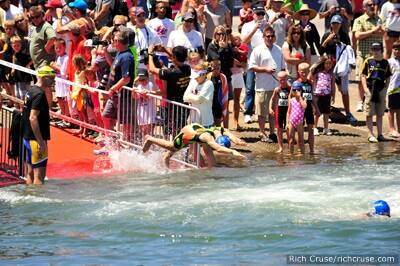Proper Youth Race Distances
by Justin Trolle
In the sport of triathlon, we are blessed to have a variety of races that are available to us both in type and in duration. With this level of variety comes some level of confusion not for ourselves but for our children and/or the kids we train. It doesn’t matter if you are a parent or a coach, we are all proud of the developing athletes with whom we work. These athletes trust us and rely on us to help them make the decisions that will guide their future in the sport. With this trust comes responsibility, and it becomes very important that the decisions that we make are in the best interest of these developing athletes and not a product of our own ambitions. We all understand the concept of parents living their dreams through their children or coaches whose own ambition takes precedent over the needs of the athlete. However, by doing this we do a disservice to those we got involved in the sport to help, the kids.
 Over the past couple of years, I have seen an alarming trend appearing in the U.S. of young kids only 13 or 14 years old doing Ironman events. This is very disturbing as this is not only dangerous to the athlete from a physiological perspective, but it also opens the door for others who may be the same age or younger to try as well. I have worked with elite athletes now for more than 15 years in triathlon as well as across all three sports individually. I have seen athletes develop from entering into the sport at 13 and 14 years old and watched them progress to become some of the best triathletes in the world. However, I have yet to see any athlete that goes long early achieve anything meaningful in the long term.
Over the past couple of years, I have seen an alarming trend appearing in the U.S. of young kids only 13 or 14 years old doing Ironman events. This is very disturbing as this is not only dangerous to the athlete from a physiological perspective, but it also opens the door for others who may be the same age or younger to try as well. I have worked with elite athletes now for more than 15 years in triathlon as well as across all three sports individually. I have seen athletes develop from entering into the sport at 13 and 14 years old and watched them progress to become some of the best triathletes in the world. However, I have yet to see any athlete that goes long early achieve anything meaningful in the long term. If as a parent or coach you are looking at setting race distances for your children or athletes, you should take the following into account:
- Never put an athlete into a race that is longer than they will be actually able to race. By this I mean don’t put developing athletes into races that they are just there to say 'I did the distance and finished.'
- Age limits – while there are no labeled age limits for athletes doing endurance events, try to use this as a guide when picking age appropriate races for your athletes:
- 7-10 years old – 50-100m Swim / 2-3km bike / 100m-1km run
- 11-12 years old – 200m Swim / 5-7km bike / 2km run
- 12-15 years old – Super Sprint ≤ 500m Swim / 10km bike / 3km run
- 15-18 years old – Sprint Distance ≤ 750m Swim / 20km bike / 5km run
- 18-23 years old – Olympic Distance ≤ 1500m Swim / 40km bike /10km run
The reason I have suggested these distances is for safety reasons and also from the point of view that if you want your athletes/children to be successful in the sport of triathlon long-term, then you need to protect them in the short-term. Endurance athletes by their very nature are a little crazy. To the general population what we do seems to be outside the realms of what people consider normal. Developing athletes often have a very active “can-do” attitude, which is great but when it come to going longer earlier just because we “can do” doesn’t mean we should "do." It is our responsibility as coaches and parents to pick races that are age/ability appropriate.
So remember, next time you are preparing your athlete/child for an event what the long-term goals are and put the child's developmental needs before your own ego. If you can do this you will get far more respect from your peers as well as better results from your athletes.
Check out our youth section, KidZone.